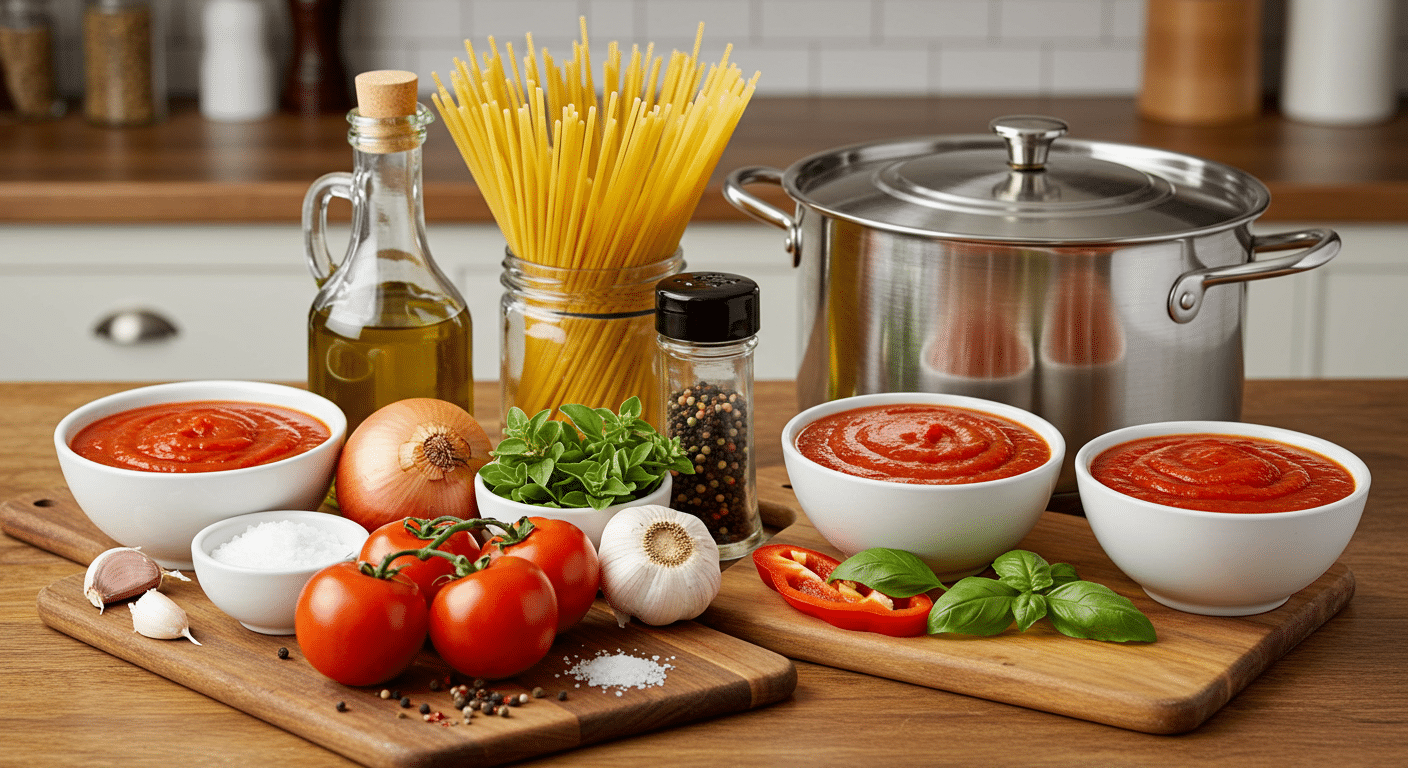The Best Homemade Canned Spaghetti Sauce
Table of Contents
Preserving fresh tomatoes in a jar is rewarding. You get to enjoy your homemade spaghetti sauce all year.
With a simple canning recipe, you can make a tasty, healthy sauce. This guide will help you get perfect results every time.
Just a few ingredients and basic tools are needed. You’ll soon make your own canning recipes a kitchen favorite.
Key Takeaways
- Learn how to make a delicious homemade sauce with fresh tomatoes.
- Understand the basics of canning and food preservation.
- Discover the benefits of having a homemade sauce pantry staple.
- Get tips on preparing and storing your canned goods.
- Follow a simple, step-by-step guide to achieve perfect results.
The Benefits of Homemade Canned Spaghetti Sauce
Making your own canned spaghetti sauce opens up a world of taste and convenience. You get to control what goes into your sauce, ensuring top quality.
Flavor and Quality Control
With homemade spaghetti sauce, you pick the freshest ingredients and seasonings. This makes your sauce taste better and more personal than store-bought.
Cost-Effectiveness
Canning your own sauce is cost-effective. Buying ingredients in bulk and canning during peak season cuts down your grocery costs.
Preservative-Free Options
Homemade canning means no preservatives, which is good for health. It’s perfect for those who prefer natural ingredients.
By making your own sauce, you get a healthier, tastier option. Plus, it saves you money.
Essential Ingredients for Perfect Spaghetti Sauce
The key to a great homemade spaghetti sauce is its ingredients. Picking the right ones is key to getting that perfect flavor mix.
Tomato Selection and Preparation
Tomatoes are the heart of any spaghetti sauce. The kind and quality of tomatoes you pick greatly affect the taste and texture of your sauce.
Best Tomato Varieties for Sauce
San Marzano tomatoes are top picks for a tangy sauce because they’re sweeter and less acidic. Roma and Plum tomatoes are also great choices.
Fresh vs. Store-Bought Tomatoes
Fresh tomatoes bring a lively taste, but canned tomatoes are handy when fresh ones are not in season. Choose high-quality canned tomatoes labeled as “san marzano” or “pomodoro.”
Herbs and Seasonings
Herbs and seasonings are crucial for boosting your sauce’s flavor. Garlic, onion, and oregano are must-haves for depth. Try adding basil and bay leaves for more complexity.
Optional Add-ins for Flavor Enhancement
For a unique twist, add red wine, mushrooms, or bell peppers to your sauce. These can add rich flavors and textures, making your sauce special.
Equipment Needed for Canning Spaghetti Sauce
Before you start canning your homemade spaghetti sauce, you need the right equipment. This makes sure the canning process is safe and works well.
Canning Jars and Lids
You’ll need canning jars and lids to store your sauce. Make sure to pick jars made for canning. They can handle the high temperatures. Also, choose lids and rings that are good for canning.
Water Bath Canner vs. Pressure Canner
When canning spaghetti sauce, you can use a water bath canner or a pressure canner. Water bath canners are best for foods with a lot of acid. But, for low-acid foods like spaghetti sauce, you need a pressure canner to keep it safe.
Additional Tools for Success
Some extra tools can help make canning easier and safer. You’ll need jar lifters, funnels, bubble removers, and headspace tools.
Jar Lifters and Funnels
Jar lifters help you handle hot jars safely. Funnels make it easier and cleaner to fill jars with sauce.
Bubble Removers and Headspace Tools
Bubble removers get rid of air bubbles in jars. Headspace tools make sure there’s the right amount of space between the sauce and the lid.

| Equipment | Purpose |
|---|---|
| Canning Jars and Lids | Storage of Spaghetti Sauce |
| Water Bath Canner or Pressure Canner | Processing Jars for Safety |
| Jar Lifters | Safe Handling of Hot Jars |
| Funnels | Efficient Filling of Jars |
| Bubble Removers | Removing Air Bubbles from Jars |
| Headspace Tools | Ensuring Correct Headspace |
Canning Spaghetti Sauce Recipe: Step-by-Step Preparation
Preparing a great canned spaghetti sauce is all about the steps you take. To make sure your sauce tastes amazing and is safe to can, follow this guide.
Blanching and Peeling Tomatoes
Blanching tomatoes makes peeling them easier and keeps the flavor and texture of your sauce intact. To blanch, boil a large pot of water, then add the tomatoes gently. Cook for 10-15 seconds until the skins wrinkle and loosen. Then, quickly move the tomatoes to an ice bath to stop cooking. Once cooled, the skins should come off easily, revealing the tender flesh.
“The art of cooking is simple: just put in the right amount of ingredients at the right time, and let the flavors meld together.”
Cooking the Sauce
After peeling your tomatoes, it’s time to cook the sauce. Mix the tomatoes with onions, garlic, and herbs. Then, simmer the mixture to get a rich, deep flavor.
Simmering Times and Techniques
Simmering is key in cooking your spaghetti sauce. Simmer it for at least 30 minutes to blend the flavors. For a thicker sauce, simmer longer. Stir occasionally to avoid burning.
Achieving the Perfect Consistency
The sauce’s consistency is up to you. Some like it thick, others thinner. Adjust the simmering time to get your desired consistency. Adding tomato paste can also thicken the sauce if needed.
Adjusting Acidity for Safe Canning
It’s important to adjust the acidity of your spaghetti sauce for safe canning. Tomatoes are acidic, but their level can vary. To ensure it’s acidic enough, add lemon juice or citric acid. Use 1 tablespoon of lemon juice or 1/4 teaspoon of citric acid per pint of sauce. This step is key to prevent spoilage and ensure the sauce is safe to eat.

| Sauce Quantity | Lemon Juice | Citric Acid |
|---|---|---|
| 1 Pint | 1 tablespoon | 1/4 teaspoon |
| 1 Quart | 2 tablespoons | 1/2 teaspoon |
By following these steps, you’ll make a delicious and safe canned spaghetti sauce. It will be a hit with family and friends.
The Canning Process: Safety and Execution
It’s crucial to can your spaghetti sauce right for its taste and safety. The canning process has key steps to follow for top-notch homemade sauce.
Sterilizing Jars and Equipment
Before filling jars, sterilize them, lids, and tools. Boil them for 10 minutes. This kills bacteria that could spoil your sauce.
Filling Jars Properly
Filling jars needs care for the sauce to be right and jars ready for processing. Here’s what to keep in mind:
Headspace Requirements
Make sure to leave the right headspace – 1/2 inch for spaghetti sauce. This space is key for a vacuum seal when cooling.
Removing Air Bubbles
After filling, use a plastic spatula to remove air bubbles. This prevents spoilage and ensures a tight seal.
Processing in a Water Bath or Pressure Canner
Next, process the jars in a water bath canner or pressure canner. Choose based on your equipment and sauce acidity. Processing times depend on jar size and altitude.
Processing Times Based on Jar Size
Water bath canning times range from 20 to 30 minutes for half-pint or pint jars. Always check a trusted canning guide for exact times.
Altitude Adjustments
At high altitudes, adjust processing times. For every 1,000 feet, water bath canning times change. Look up the exact adjustments in a reliable canning resource.
Cooling and Testing Seals
After processing, cool jars on a wire rack. After 24 hours, check the seals. If the lid doesn’t move and the seal is tight, it’s sealed right.
Storage and Shelf Life of Canned Spaghetti Sauce
After canning your spaghetti sauce, it’s key to store it right. This keeps it tasting good and safe to eat. The right storage helps keep your canned goods fresh longer.
Proper Storage Conditions
Keep your canned spaghetti sauce in a cool, dark spot. Think a pantry or cupboard. The best temperature is under 75°F (24°C). Don’t store cans near heat sources or sunlight, as this can harm the sauce.
Signs of Spoilage to Watch For
Canned goods can spoil, even with good storage. Always check your spaghetti sauce for spoilage before eating it.

Visual Indicators
Look for mold, rust, or swelling on the can or lid. If the can is dented, check for sharp edges or leaks.
Smell and Texture Changes
Check for bad smells or a slimy texture. If the sauce looks separated or has an odd color, it’s best to throw it away.
| Storage Condition | Effect on Canned Goods |
|---|---|
| Cool, Dark Place | Preserves flavor and extends shelf life |
| High Temperature | Can lead to spoilage and safety issues |
| Direct Sunlight | Can cause degradation of quality |
Conclusion
Now you know how to make tasty homemade canned spaghetti sauce. Follow the canning tips in this guide to keep your pantry full of delicious sauce all year. This way, you can enjoy homemade flavor without preservatives.
With your homemade sauce, pasta nights will be better, and weeknights quicker. You can also share your homemade sauce with loved ones. The effort is worth it for the delicious results.
Keep improving your canning skills and try new ingredients and flavors. This will help you make different versions of your favorite sauce. You’ll have a wide range of homemade spaghetti sauce for any occasion.
FAQ
What is the best type of tomato to use for homemade canned spaghetti sauce?
For homemade canned spaghetti sauce, use paste tomatoes like San Marzano or Roma. They have a dense texture and less water, making the sauce richer and thicker.
How do I ensure my canned spaghetti sauce is safe to eat?
To keep your sauce safe, follow tested canning steps. Sterilize jars and tools, fill jars right, and process them in a water bath or pressure canner. Check seals after cooling. Adjust acidity to prevent spoilage.
Can I use a pressure canner for canning spaghetti sauce?
A water bath canner is best for high-acid foods. But, a pressure canner works for low-acid foods like some spaghetti sauces. Always use tested recipes and guidelines for your chosen method.
How long does canned spaghetti sauce last?
Canned spaghetti sauce lasts 12 to 18 months if stored right. Keep jars in a cool, dark place. Check seals often. Once opened, refrigerate and use within a few days.
What are the signs of spoilage in canned goods?
Look for swelling, rust, leakage, or a bad smell in canned goods. Check for mold, sliminess, or color changes. If unsure, throw it away to avoid illness.
How do I adjust the acidity of my spaghetti sauce for safe canning?
Add lemon juice or citric acid to adjust acidity. The needed level depends on your recipe and canning method. Always check a reliable canning resource or tested recipe for guidance.
Can I can spaghetti sauce with meat?
Yes, you can can sauce with meat. But, follow safe canning practices for low-acid foods. This might need a pressure canner to kill bacteria.
What is the importance of headspace in canning?
Headspace is the gap between food and the jar lid. The right headspace is key for a vacuum seal and preventing spoilage. The needed headspace varies by food and canning method.

